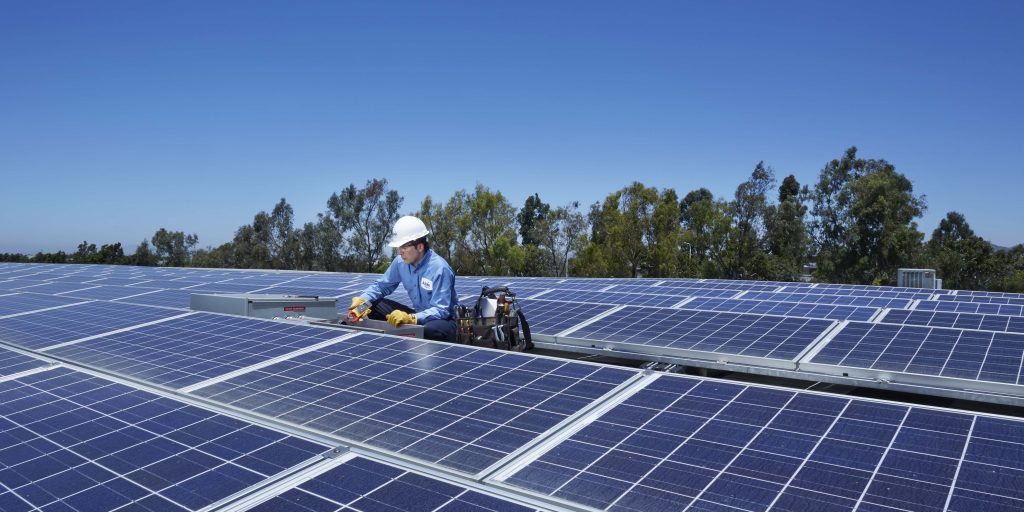Fund your resiliency efforts with energy savings
Connecting needs and resources can feel like the proverbial walk to school – uphill both ways. Despite increasing complexity in building consensus and procuring funding, communities are finding ways to meet growing needs with an expert eye on energy and operational spending.
Energy projects aren’t just cutting costs and keeping up with aging infrastructure, they’re helping leaders meet challenges like resiliency in the face of increasing extreme weather events. Finding ways to fund renewable sources like solar creates resiliency for communities. Cost savings can help shift spending to communication reliability or compliance with updated safety codes.
A fiscally responsible foundation
The basic idea of an energy project is to undo a paradox, where great cost savings is trapped behind investments you can’t make without saving costs. By turning that problem on its head, an energy project uses the savings it will generate to make those savings happen. But that’s just the baseline. Today’s energy projects go farther than retrofits and deferred maintenance. Those are important to communities, but so are increasing infrastructure challenges like sustainability and resilience.
Resilience is about bouncing back from damaging events. Communities face rising threats from heat waves, storm intensity, and extreme participation events. That’s increasing the risk of floods, fires, and storm damage. Heat waves pose a special risk to the elderly and drive spikes in energy consumption, increasing threats to our grid. The usual metaphor for converging crisis factors is “the perfect storm,” and it’s apt in this case. Pair those rising threats with aging infrastructure – estimated to cut into U.S. GDP by as much as $3.9 trillion by 2025 and community leaders are right to reach for creative solutions.
The upside to energy projects is they can bring benefits that address multiple sides of those issues. Energy savings, sustainability, and energy resiliency can be accomplished together.
Real change Is always local
Over half of America’s mayors plan to address sustainability and climate issues in the next year. That makes a lot of sense when you learn that 95% of mayors report that climate issues have impacted their communities recently, including flooding, snow and ice storms, wildfires, heat waves, and drought. Projects that improve sustainability can also improve resiliency. An energy project that helps reduce emissions could also help communities deal with high-impact weather events.
For instance, we know that upgrading to electrical vehicles increases fuel efficiency and cuts emissions. It also creates resiliency, with vehicle batteries available to power emergency shelters or communication systems.
An energy project could generate savings to help defray the costs of solar power for a local government. Depending on the project, energy savings from the solar installation itself could then be used to fund other energy project goals without upfront costs.
Solar energy can also be a big resiliency factor for a community. It’s an alternative source of power that isn’t dependent on other fuel or energy sources. Battery backups or microgrids to support solar and other alternative sources create even more resiliency.
The multiplier effect
It may seem like a lot of dots to connect, from saving energy with an LED retrofit or HVAC upgrade to making communities safer during extreme weather events, but it really isn’t. If infrastructure issues, maintenance problems, or runaway energy spending bog down a budget, that’s just the first time that money is wasted.
That waste weighs down budgets again and again, narrowing choices with ever-increasing costs. Cutting waste breaks that cycle and gives leaders the power to do more for their communities.
An energy project turns that cycle around and uses savings to create multiplying benefits. For instance, savings in energy costs that help fund a new solar installation not only create more opportunities to cut energy costs in the future, they reduce dependency on other sources of energy or fuel.
Even simple upgrades can multiply operational savings down the road. Improved communications, remote building controls, and other smart upgrades empower new and improved operations. There’s lots of outcomes to consider. For instance, insurance rates for a local government can be impacted by infrastructure preparedness. Resiliency can also be a factor in bond ratings, affecting the cost of investing in a community’s future across the board.
Getting to resiliency goals from here
Beginning with an energy audit, local governments can get a close look at their current energy and operational expenses. The audit should reveal infrastructure issues that lead to inflated costs and identify opportunities.
A project can then be developed to upgrade building systems and equipment, generating substantial savings that can be repurposed for resiliency goals. Expert analysis can make the difference between cutting services to citizens and generating more benefits for communities.
Joel Lowery is Vice President of Sales with ABM in Atlanta, Ga. He has 30 years of experience helping local governments and their leadership to provide funding for many of their challenges by implementing innovative solutions through ABM’s energy performance contracting program. For more information, contact Joel at [email protected].




















